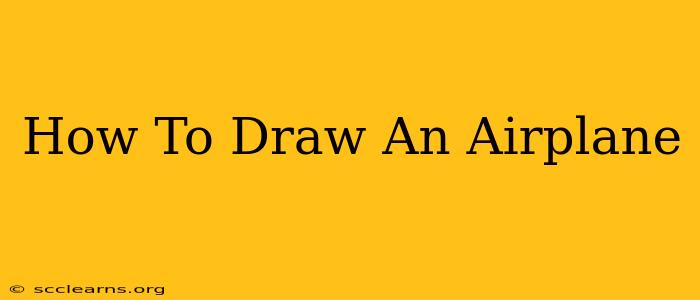So you want to learn how to draw an airplane? Whether you're a seasoned artist or just picking up a pencil for the first time, this guide will walk you through the process, from basic shapes to adding intricate details. We'll cover different airplane types and styles, ensuring you can create the perfect aircraft for your artistic needs. Let's take flight!
Getting Started: Essential Materials and Techniques
Before we soar into the world of airplane drawing, let's gather our supplies:
- Pencil: A standard HB or 2B pencil is perfect for sketching. You might also want a harder pencil (like a 4H) for lighter guidelines.
- Eraser: A good quality eraser is crucial for correcting mistakes. A kneaded eraser is particularly useful for lifting pencil marks without damaging the paper.
- Paper: Use drawing paper; the smoother the better for detailed work.
- Optional: Colored pencils, markers, or paints for adding color and depth to your finished drawing.
Basic Shapes: The Foundation of Your Airplane
Airplanes, at their core, are made up of simple geometric shapes. Mastering these shapes is the key to creating realistic and stylized airplanes.
- Fuselage: This is the main body of the airplane. Start by drawing a long, slightly tapered oval or cylinder.
- Wings: Typically, these are elongated rectangles or trapezoids attached to the fuselage. Consider the wingspan and how the wings connect to the body.
- Tail: The tail section usually consists of a vertical stabilizer (the fin) and a horizontal stabilizer. These can be drawn as simple rectangles and triangles.
Drawing Different Types of Airplanes
Let's explore drawing a few common airplane types, applying the basic shapes we just discussed:
1. Drawing a Simple Propeller Airplane
- Fuselage: Draw a long oval for the fuselage.
- Wings: Attach two slightly curved rectangles to the fuselage.
- Tail: Add a vertical rectangle (fin) and a smaller horizontal rectangle (horizontal stabilizer).
- Propeller: Draw a circle for the propeller and add blades extending from it.
2. Drawing a Jet Airplane
- Fuselage: Draw a long, slender oval or tube for the fuselage. Jet fuselages tend to be more streamlined.
- Wings: Add swept-back wings, meaning the trailing edge points backward.
- Tail: Include a vertical stabilizer and horizontal stabilizers.
- Engines: Draw smaller cylinders or oval shapes for the jet engines at the rear of the fuselage.
3. Drawing a Cartoon Airplane
Cartoon airplanes are all about fun and expressive designs. Don't be afraid to exaggerate features!
- Fuselage: Draw a simple, rounded shape. It could be a big balloon, a box, or even a smiling face.
- Wings: Use bright colors and exaggerated curves for the wings.
- Tail: Add a whimsical tail design, perhaps with a propeller made of hearts or stars.
- Details: Don't forget to add big, expressive eyes and a friendly smile!
Adding Details and Shading
Once you've got the basic structure down, it's time to add details that bring your airplane to life.
- Windows: Add small rectangles or circles along the fuselage for windows.
- Landing Gear: Draw the wheels under the body.
- Control Surfaces: Add small flaps and ailerons on the wings.
- Shading: Use shading to create depth and dimension. Pay attention to where light would naturally hit the airplane and add darker shadows to the opposite sides.
Practice Makes Perfect
The key to mastering any art form is practice. Start with simple shapes and gradually add more detail as your confidence grows. Don't be afraid to experiment with different styles and techniques. The more you draw, the better you will become at capturing the form and spirit of an airplane.
Beyond the Basics: Exploring Different Perspectives and Styles
Once you're comfortable with basic airplane drawings, try experimenting with different perspectives:
- Side View: The simplest perspective, showing the airplane from the side.
- Top View: Shows the plane from above, useful for illustrating wingspan and tail design.
- Three-Quarter View: A more dynamic view that combines elements of side and front perspectives.
You can also try different art styles, like:
- Realistic: Aiming for photorealistic accuracy.
- Stylized: Using artistic license to create a unique, non-realistic look.
- Abstract: Focusing on shapes and colors rather than precise representation.
Remember, have fun with it! Drawing should be an enjoyable process. So grab your pencils and let your imagination take flight.

